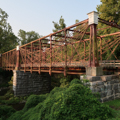This 160-foot-long, two-span, through-truss bridge next to Savage Mill is thought to be the only remaining example of the Bollman bridge design critical to the development of the railroad in the mid-nineteenth century. Baltimore engineer Wendel Bollman patented his design in 1852 for a uniquely strong composite bridge truss structure of cast and wrought iron. The thicker cast-iron members worked in compression while the thinner wrought-iron ones worked in tension to create a hybrid system combining elements of a suspension bridge and a rigid truss. The Bollman suspension truss offered the durability of a metal bridge while still being relatively inexpensive and easy to build, making it the first all-iron bridge to be adopted and widely used by a railroad. Bollman’s first bridge using this method was actually built here in Savage for the B&O Railroad spanning the Little Patuxent River in 1850. However, the current structure was fabricated in 1869 and moved from the main railroad line to the small spur line serving Savage Mill in 1888. It sits on granite abutments with a single mid-river granite pier.
Between 1850 and 1875 more than a hundred Bollman suspension truss bridges were built for the B&O and other railroads. While many remained in service into the twentieth century, the design was later supplanted by bridges that could carry heavier loads. In recognition of its importance to railroad history and its rare survival, this bridge was designated the first National Historic Civil Engineering Landmark by the American Society of Civil Engineers in 1966 and a National Historic Landmark in 2000.


















